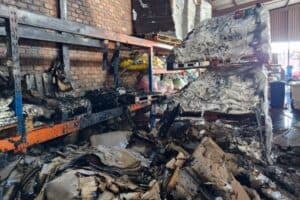According to the Ekurhuleni municipality, around 750 fresh graves are required every month, this equates to 9 000 spots annually.

Large metros like Ekurhuleni are fast running out of burial space. In an environment where the population continues to grow, so too, does the demand for demarcated areas to inter bodies.
In its annual engagement with undertakers, city officials have proposed several solutions to a growing challenge where delays and scarcity of plots often frustrate families seeking to pay their last respects.
According to Zweli Dlamini, spokesperson for Ekurhuleni, around 750 fresh graves are required every month, this equates to 9 000 spots annually.
ALSO READ: Gravesite crisis: Are vertical cemeteries a solution to our lack of space?
However, Bheki Hlahane of Royal Funerals said demand may be much higher than that. “Our service alone interred 123 bodies in October,” he noted. There are more than 25 funeral homes in Ekurhuleni.
Typically, a single grave site requires 2.4 metres by almost 1 metre in surface area. This means that the annual demand for sites in the metro equates to just more than 19 000m2.
Over time, this stacks up to a lot of land. “The shortage of burial space can be attributed to various factors, including population growth, insufficient land acquisition for cemetery development to meet increasing demand for burials and unsuitable land portions within cemeteries,” said Dlamini.
Info
• Typically, a single grave site requires 2.4 metres by almost 1 metre in surface area.
• This means that the annual demand for sites in the metro equates to just more than 19 000m2 .
• Over time, this stacks up to a lot of real estate.
• The balance of available space after 2024 will likely be filled by 2025.
Humans are the only animals that bury their dead and, while anthropologists celebrate this as an evolutionary win, it causes major town planning headaches. Bodies cannot be placed in any old ground.
Soil composition is critical, as sandy or clay-rich levels cannot lean too much in either direction. It must be stable to ensure proper decomposition.
Erosion also plays a major role as overall land areas are required to be stable and not prone to significant earth movement.
Then, too, drainage is crucial to prevent waterlogging, as this could negatively impact decomposition or pose health risks should it flood, and sites can also not be near water sources for the same reasons.
ALSO READ: Lenasia Avalon Cemetery reaches capacity for burials
Follow this with challenges of proximity, religious and cultural practices and it shrinks the potential availability of burial land substantially.
“The community of Tembisa has been facing a growing challenge as they are forced to travel long distances for burial and to visit their loved ones.
This is becoming common as the burial space shrinks every year,” said Dlamini. In 2015, the metro already said that it was running out of space and that there was only 30 years’ of burial space left. Eight years later, the same conversation is being had.
“Nothing has been done,” said Hlahane. “It has been talking until now, so frequent promised consultations are a step in the right direction,” he added.
ALSO READ: WATCH: Criminals destroy, steal and vandalize facility at Avalon Cemetery
Hlahane pointed out that many cemeteries in the city will be at capacity by the end of next year and the balance of available space will likely be filled by the end of 2025.
It is becoming a crisis. Alternatives were pitched to the funeral industry that included greater focus on cremation and other space-saving options.
“We are considering other alternatives such as mausoleums at cemeteries where the ground is not suitable for in-earth burial, crematoriums and the cremation of paupers,” added Dlamini.
Cemetery and crematorium by-laws, policies and tariffs were also on the agenda, along with procedures and requirements for cemeteries and crematoriums.
ALSO READ: Mountain of trash, fire ‘toxic’ in Ekurhuleni
Over the past 10 years, several other private interment solutions were launched, including ecoparks and seeded burials, where decomposing bodies are used as fertilizer to sprout a tree, that would eventually grow out of a loved one’s remains.
But so far, these kinds of innovations have not impacted demand for traditional interments – a grave dug in the ground.
The sole Ekurhuleni municipal crematorium is “not reliable” and sometimes works and sometimes doesn’t.
“We have also suggested that graves be dug deeper to accommodate up to three family members,” said Dlamini.
ALSO READ: Threat to lay criminal charges against EFF after violent Ekurhuleni council clash
This solution was also mooted eight years ago and received resistance at the time, with people believing that individuals would be buried with strangers.
The city denied it at the time. Hlahane said it might be the only solution left. “It will require substantial community engagement and cultural sensitivity,” he said, “but it is really the only solution.”
Hlahane said that bylaws would have to be changed to accommodate stacked interments.






